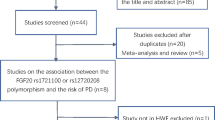Abstract
Fibroblast growth factor 20 (FGF20) widely expressed in the substantia nigra is a neurotrophic factor and enhances the survival of midbrain dopaminergic neurons. Genetic association between variants in FGF20 gene (rs1721100) and PD has been reported, however, the results have been conflicting. A total of 3,463 PD patients and 4,606 controls from 5 case–control studies, which were identified by searching Web of Science, Embase and PubMed database up to March 2014, were collected for this meta-analysis. The meta-analysis showed an association between FGF20 gene rs1721100 polymorphism and risk of Parkinson’s disease under a recessive model (GG versus CG+GG; OR = 1.15, 95 % CI 1.02–1.29, p = 0.02) but not under a dominant model (CG+GG versus CC; OR = 1.03, 95 % CI 0.93–1.13, p = 0.57). These findings suggest that rs1721100 GG genotype within FGF20 gene is a risk factor for PD. To our knowledge, this is the first meta-analysis to access to the association of FGF20 gene rs1721100 polymorphism with PD risk.





Similar content being viewed by others
References
de Lau LML, Breteler MMB (2006) Epidemiology of Parkinson’s disease. Lancet Neurol 5:525–535
Mizuno Y, Hattori N, Kubo S et al (2008) Progress in the pathogenesis and genetics of Parkinson’s disease. Philos Trans R Soc Lond B Biol Sci 363:2215–2227
Jeffers M, Shimkets R, Prayaga S et al (2001) Identification of a novel human fibroblast fibroblast growth factor and characterization of its role in oncogenesis. Cancer Res 61:3131–3138
Ohmachi S, Watanabe Y, Mikami T et al (2000) FGF-20, a novel neurotrophic factor, preferentially expressed in the substantia nigra pars compacta of rat brain. Biochem Biophys Res Commun 277:355–436
Ohmachi S, Mikami T, Konishi M et al (2003) Preferential neurotrophic activity of fibroblast growth factor-20 for dopaminergic neurons through fibroblast growth factor receptor-1c. J Neurosci Res 72:436–443
Rideout HJ, Dietrich P, Savalle M et al (2003) Regulation of a-synuclein by bFGF in cultured ventralmidbrain dopaminergic neurons. J Neurochem 84:803–813
Kirikoshi H, Sagara N, Saitoh T et al (2000) Molecular cloning and characterization of human FGF-20 on chromosome 8 p21.3-p22. Biochem Biophys Res Commun 274:337–343
Wang G, van der Walt JM, Mayhew G et al (2008) Variation in the miRNA-433 binding site of FGF20 confers risk for Parkinson disease by overexpression of alphasynuclein. Am J Hum Genet 82:283–289
Van der Walt JM, Noureddine MA, Kittappa R et al (2004) Fibroblast growth factor 20 polymorphisms and haplotypes strongly influence risk of Parkinson disease. Am J Hum Genet 74:1121–1127
Gao X, Scott WK, Wang G et al (2008) Gene-gene interaction between FGF20 and MAOB in Parkinson disease. Ann Hum Genet 72(Pt 2):157–162
Scott WK, Nance MA, Watts RL et al (2001) Complete genomic screen in Parkinson disease: evidence for multiple genes. JAMA 286(18):2239–2244
Clarimon J, Xiromerisiou G, Eerola J et al (2005) Lack of evidence for a genetic association between FGF20 and Parkinson’s disease in Finnish and Greek patients. BMC Neurol 5:11
Wider C, Dachsel JC, Soto AI et al (2009) FGF20 and Parkinson’s disease: no evidence of association or pathogenicity via alpha-synuclein expression. Mov Disord 24:455–459
Xu X, Wang N, Xu H et al (2013) Fibroblast growth factor 20 polymorphism in sporadic Parkinson’s disease in Northern Han Chinese. J Clin Neurosci 20(11):1588–1590
Satake W, Mizuta I, Suzuki S et al (2007) Fibroblast growth factor 20 gene and Parkinson’s disease in the Japanese population. NeuroReport 18:937–940
Pan J, Li H, Wang Y, Ma JF et al (2012) Fibroblast growth factor 20 (FGF20) polymorphism is a risk factor for Parkinson’s disease in Chinese population. Parkinsonism Relat Disord 18(5):629–631
de Mena L, Cardo LF, Coto E et al (2010) FGF20 rs12720208 SNP and microRNA-433 variation: no association with Parkinson’s disease in Spanish patients. Neurosci Lett 479:22–25
Ustinova VV, Shadrina MI, Fedotova EIu et al (2012) Analysis of the rs12720208 single-nucleotide polymorphism of the FGF20 gene in Russian patients with sporadic Parkinson’s disease. Genetika 48(12):1437–1439
Acknowledgments
This work was supported by the National Natural Science Foundation of China (30971018). We are deeply grateful to all participants of this study.
Conflict of interest
None.
Author information
Authors and Affiliations
Corresponding author
Rights and permissions
About this article
Cite this article
Zhu, R., Zhu, Y., Liu, X. et al. Fibroblast growth factor 20 (FGF20) gene polymorphism and risk of Parkinson’s disease: a meta-analysis. Neurol Sci 35, 1889–1894 (2014). https://doi.org/10.1007/s10072-014-1853-y
Received:
Accepted:
Published:
Issue Date:
DOI: https://doi.org/10.1007/s10072-014-1853-y




